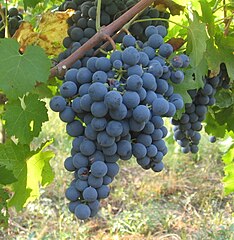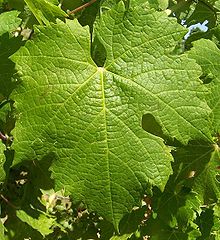Carménère
| Carménère | |
|---|---|
| Synonyms | Grande Vidure - for more see the Synonyms section |

|
|
| Art | Grape vine ( Vitis vinifera subsp. Vinifera ) |
| Berry color | blue black |
| use | |
| origin | France |
| VIVC no. | 2109 |
| ancestry | |
|
natural cross of Moural × Cabernet Franc |
|
| List of grape varieties | |
Carménère , sometimes called Grande Vidure, is a red wine variety . It originally comes from France ( Bordeaux ), where it was cultivated very frequently until the phylloxera disaster in the middle of the 19th century. To this day it is one of the six grape varieties that can be used for red wines in Bordeaux (the other varieties are Cabernet Sauvignon , Cabernet Franc , Merlot , Malbec and Petit Verdot ). Before the phylloxera infestation, Carménère was a very common blending partner in ( Bordeaux ) wines.
After the phylloxera infestation, however, it almost completely disappeared there because the French winemakers preferred other varieties when they were setting up their new vineyards. The variety is very sensitive to flowering in damp, cold weather and likes to trickle . Therefore, the variety delivers low yields in difficult years. In addition, it takes around three weeks longer to ripen than Merlot, for example, with which the grape is often confused.
origin
Carménère is a natural cross of Gros Cabernet and Cabernet Franc . Other sources also cite the Moural grape variety as a parent.
Ampelographic variety characteristics
- The shoot tip is open. It is moderately hairy, woolly, but white in color with pink dots. The greenish young leaves are hairy cobwebs with a slightly bronze-colored tinge.
- The large leaves are five-lobed and strongly indented (see also the article leaf shape ). The stalk bay is lyren-shaped, more or less closed. The sheet is serrated. The teeth are medium-sized compared to the grape varieties. The leaf surface is hardly blistered and shiny. In autumn, the leaves turn slightly reddish.
- The mostly conical to cylindrical grape is small and loose berries. The round berries are medium-sized and blue-black in color.
- The growth is strong.
Ripeness: Physiologically, the grapes ripen about two weeks later than those of the Gutedel .
Yield
Usually delivers low yields due to the trickling of the flower.
Wine
The Carménère grape is used to make a low-tannin , darker, more palatable red wine that tastes like chocolate, tobacco and leather with a pleasant berry aroma. The expansion of Carménère is mainly pure varietal . Interesting and complex wines can be achieved by storing them in French and American oak barrels . For a long time it was controversial whether the Carménèrerebe is more related to Merlot or Cabernet Sauvignon . The variety differs from Merlot in that it ripens later and its leaves are reddish in color. Their taste is richer than that of Merlot. After Cabernet Sauvignon and Cabernet Franc, Carménère is considered to be the third “heaviest” of the known and popular French red wine varieties. It is followed in stages by the red grape varieties Malbec, Syrah , Merlot and Pinot Noir .
distribution
Chile
Carménère has been grown in Chile since 1850 . In the Andean country, the sensitivity of the vine to the cool European weather does not matter. The thermometer rarely falls below the 10 ° C mark on summer nights. Since Carménère and Merlot vines are very similar externally, vines imported from France were mostly planted in "mixed stands" in Chile. Because the grape variety almost completely disappeared in France due to the phylloxera plague, the name Carménère fell into oblivion at the beginning of the 20th century. From then on, the Chilean vines were thought to be a variant of Merlot because of their similarity. However, nobody could explain the clear taste difference between Merlot wines from Chile and those from other countries.
The French ampelographer (vine researcher) Jean-Michel Boursiquot was finally able to eliminate this mistake in 1994 through DNA analysis . The Chilean winery "Carmen" only produced the first pure Carménèrewein in 1996.
The Chilean winemakers recognized the chance of being able to offer a grape variety practically exclusively and increased the area under cultivation of the Carménère. In the lower price segment there are many mixed wines in which the Carménèrerebe is matched with Merlot, Cabernet Sauvignon or Cabernet Franc. The large Chilean winery Concha y Toro alone now has a Carménère stock of over 100 hectares. The single varietal wines mature for three to four years in barriques made from French and American oak.
Since Chile was spared the phylloxera plague due to its geographical conditions, the wine country turned into an exporter of the old Bordeaux grape variety Carménère. They are now re-imported from many wine producing countries, including France. With Carménère, there are now more than 7,180 hectares of vineyards in Chile, mainly in the subregions of Rapel and Maule in the Central Valley .
Italy
A similar situation arose in Italy in 1990 when the Ca 'del Bosco winery ( Erbusco , in the Franciacorta region ) ordered Cabernet Franc sticks from a French nursery. When the cellar masters developed the first wines from these vines, there were differences in taste and color with regard to old plantings. An initial examination in the vineyard showed that the new vines ripened earlier than usual. Since other Italian winemakers also felt affected, the affected plants were analyzed and identified as Carménère. The previously known plantings are all in northern Italy. The grape variety was only recently added to the Italian list of varieties . For a long time, however, no Italian province initiated an approval procedure that would recognize the Carménère as a quality grape variety and give the wine (single-variety or blended) an IGT , DOC or DOCG status . It was therefore reserved for large and well-known estates to grow Carménère as table wine and still market it at good prices. For example, the Ca 'del Bosco winery produces Carmenero wine .
Since the 2009 vintage , the Veneto region has had the Piave Carménère , the first designation of origin with the status of a DOC dedicated to Carménère. The Vigna Dogarina winery in Campodipietra is considered one of the good producers of this grape variety.
Australia
Viticulture expert Richard Smart, known in Australia, imported three Carménère seedlings from Chile at the end of the 1990s. However, only one sapling survived the prescribed quarantine period of two years. Through in vitro propagation as part of the plant tissue culture , enough seedlings could be produced in the Australian Narromine nursery to carry out the first test plantings. The Amietta winery in the Moorabool Valley near Geelong in the state of Victoria was the first winery in Australia to plant the Carménère and use the wine produced in the Angels' Share blend.
New Zealand
Carménère is also produced in small quantities in New Zealand. DNA analysis carried out in 2006 confirmed that smaller stocks in the Matakana region were erroneously referred to as Cabernet Franc.
Other countries
Smallest stocks are known in Switzerland ( viticulture in Switzerland ) (0.07 ha, status 2009, source: Office fédéral de l'agriculture OFAG).
Synonyms
34 other names are known for the grape variety: Bordo, Bouton Blanc, Caberne Karmener, Cabernella, Cabernelle, Cabernet, Cabernet Carmenere, Cabernet Cosmo, Cabernet Gernicht, Cabernet Gernischet, Cabernet Gernischt, Cabernet Gerniseht, Cabernet Grande, Cabernet Grosso, Cabernet Italico , Cabernet Shelongzhu, Carbonet, Carbouet, Carmenea, Carmenegre, Carmenelle, Carmeneyre, Francesa Nera, Gran Vidyur, Grand Carmenet, Grande Vidure, Grande Vuidure, Grosse Vidure, Kaberne, Kaberne Karmener, Kabernel, Karmene, Karmensel, Uva Francesca .
Web links
- Carménère in the database Vitis International Variety Catalog of the Institute for Vine Breeding Geilweilerhof (English)
Individual evidence
- ↑ a b Carménère in the database Vitis International Variety Catalog of the Institute for Grapevine Breeding Geilweilerhof (English)
- ↑ Merlot, la découverte du chaînon manquant! - Institut français de la vigne et du vin. In: www.vignevin.com. Retrieved November 5, 2016 .
- ↑ Merlot, la découverte du chaînon manquant! (No longer available online.) Française de la Vigne et du Vin Institute, February 19, 2009, archived from the original on January 22, 2015 ; accessed on March 13, 2015 . Info: The archive link was inserted automatically and has not yet been checked. Please check the original and archive link according to the instructions and then remove this notice.
- ↑ Julius Kühn Institute (JKI), Federal Research Center for Cultivated Plants, Institute for Grapevine Breeding, Geilweilerhof, Siebeldingen, Erika Maul, Reinhard Töpfer, Rudolf Eibach, Alina Ganesch: CARMENERE. In: www.vivc.de. Retrieved November 5, 2016 .
- ↑ Catastro Viticola Nacional 2006. (PDF; 135 kB) División Protección Agrícola - SAG, 2007, accessed on November 26, 2014 (Spanish).
- ^ H. Johnson & J. Robinson The World Atlas of Wine pg 298 Mitchell Beazley Publishing 2005 ISBN 1-84000-332-4
- ↑ Terlato Wines International ( Memento of October 18, 2010 in the Internet Archive )
- ↑ Production regulations and description ( Memento of the original from April 28, 2016 in the Internet Archive ) Info: The archive link was inserted automatically and has not yet been checked. Please check the original and archive link according to the instructions and then remove this notice. (PDF) wineacts.com (Italian), accessed December 29, 2017
- ↑ The wine year 2009 ( Memento of the original from July 12, 2016 in the Internet Archive ) Info: The archive link has been inserted automatically and has not yet been checked. Please check the original and archive link according to the instructions and then remove this notice. (PDF), publisher Office fédéral de l'agriculture OFAG
- ↑ Carménère in the database Vitis International Variety Catalog of the Institute for Grapevine Breeding Geilweilerhof (English), accessed on January 16, 2020
literature
- Jancis Robinson : The Oxford Wine Lexicon . Hallwag, Gräfe and Unzer, Munich 2006, ISBN 978-3-8338-0691-9 .
- Pierre Galet : Dictionnaire encyclopédique des cépages, page 253 . 1st edition. Hachette Livre, 2000, ISBN 2-01-236331-8 .

